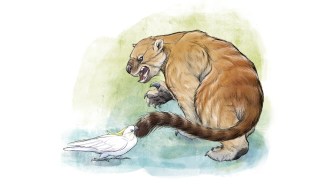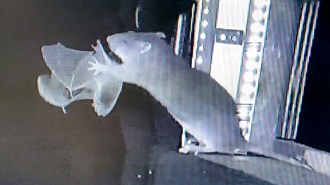Odd bubbles of fat and gas have turned up in the bodies of marine mammals, raising the question of whether something about human activity in the oceans could give such magnificent divers decompression sickness.
Divers of the human sort who shoot upward too fast develop dangerous bubbles of nitrogen in their tissues. But physiologists have long marveled at adaptations in marine mammals that prevent a cetacean version of the bends. “It’s never been described before,” says Tony Patterson of the Scottish Agricultural College’s Veterinary Sciences Division in Inverness.
Now, Patterson, Paul Jepson of the Zoological Society of London, and their colleagues report lesions in the animals’ tissues that the researchers say might be the fingerprints of such decompression damage. Ten beaked whales that stranded themselves on shore during military maneuvers hosted by Spain last fall near the Canary Islands show unusual bits of fat in vital organs–an indication of trauma, say the researchers. Also, looking back over a decade of stranding records from Britain, the researchers found seven dolphins and porpoises and one beaked whale with puzzling gas bubbles.
The possibility of decompression damage takes on ominous overtones because theorists have proposed that sonar from ships might cause formation of gas bubbles in nearby marine mammals, the researchers say in the Oct. 9 Nature.
Last fall’s Canary Island stranding began on Sept. 24, just 4 hours after naval ships began using midfrequency sonar. Fourteen beaked whales stranded themselves and at least 11 died. In the 10 carcasses examined, the researchers found numerous spots of fat and tiny hemorrhages in various organs.
The records for the one other beaked whale, as well as dolphins and porpoises, came from a British network that keeps track of stranded marine mammals. From October 1992 to January 2003, for example, 3 out of 342 common dolphins that had been stranded and 1 out of 1,035 stranded harbor porpoises showed gas bubbles in their blood vessels and other organs. The damage looked as if it had existed awhile, because tissue around the bubbles had turned fibrous, says Patterson. For these cases, there’s no evidence one way or the other about the animals’ exposure to ships’ sonar, he says.
The hypothesis that a blast of sound can trigger tiny, gaseous nuclei of nitrogen to balloon into bubbles in tissue is “plausible,” comments Roger Gentry, who coordinates marine-mammal acoustics research for the U.S. National Oceanographic and Atmospheric Administration (NOAA) in Silver Spring, Md. The idea was debated at a NOAA workshop in 2002 and generally deemed feasible, says Gentry. He emphasizes, however, that scientists have a long way to go in answering questions about the idea.
For example, do bubble nuclei expand enough to injure diving animals? asks Darlene Ketten of Woods Hole Oceanographic Institution in Woods Hole, Mass. She rates the new Nature paper as “intriguing” but has lots of questions about the interpretation of the carcass examinations. For instance, she wonders whether the researchers can rule out other possible traumas as the cause of the fat spots.
****************
If you have a comment on this article that you would like considered for publication in Science News, send it to editors@sciencenews.org. Please include your name and location.







